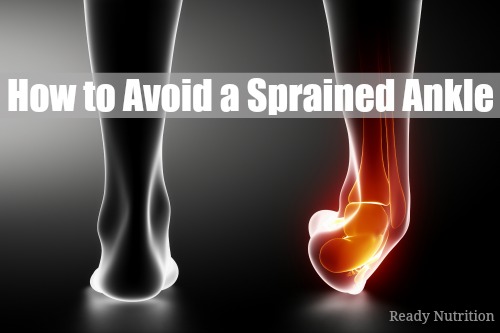In an emergency situation, it is imperative that you are healthy and strong enough to remain alert, prepared, and most of all, mobile. You have no way of knowing if your home base will be compromised or not and/or if a natural disaster or other circumstance will have you on the run. Something as seemingly innocuous as a sprained ankle can mean the difference between making a getaway or getting stuck.
History Repeats Itself
Many people will tell you that they have suffered from a sprained or twisted ankle at some point in their lifetime. However, more than half of those people who have done so never seek professional medical treatment because it is “just a sprain” and they don’t see how a doctor can help them. This is risky because the majority of ankle sprains will occur again at some point later in life. A sprained ankle that does not receive the appropriate physical therapy during and after healing often results in a weaker joint. This can lead to a myriad of issues, including problems maintaining proper balance, developing a slight limp or altered gait, and having a joint that is unstable and more likely to twist or collapse again. In very serious cases, a sprained ankle left untreated can result in a lifetime of pain and immobility.
Bad Advice Following a Sprain
There is a lot of really bad advice out there about what to do following a sprained ankle. The worst of all is the adage to “walk it off” or ignore a sprain. You must immediately stop doing whatever exercise or activity caused the sprain and take all weight off of the ankle. The moments following a sprain are the most critical when inflammation and swelling put the joint at risk. If possible, head to the ER for a medical consultation, especially if the pain is severe and lasts for more than a few days. Although in most cases, an X-ray or M.R.I. is not needed to make an accurate diagnosis, you need to rule out the possibility of a more severe injury. A doctor can give you a plan for therapy to strengthen and heal the joint.
Prevention is the Best Plan
Your best bet is to not get an ankle injury in the first place. This means wearing appropriate shoes for your activity, protecting your joints, and making sure that the ground surfaces you are using are level and clear of all debris. A majority of ankle sprains occur not during intensive sports or activities but in everyday walking situations. Don’t put your health at risk for fashion trends—keep your shoes low-heeled with sufficient tread. Hold onto handrails when walking up or downstairs, and limit walking in icy or very wet conditions if possible.
The stronger your ankles are, the more you can avoid getting an ankle injury in the first place. The muscles around your joint help to protect and stabilize, so building up those muscles with the following exercises can be very beneficial.
Three Exercises that Strengthen the Ankle
Ankle Alphabet
Sit on the ground with your knees up and your legs bent in front of you. Cross one leg over the other and “trace” the shape of each letter of the alphabet with your ankle. This will feel very easy at first but by the end of the alphabet, you might have trouble remaining steady or completing the shapes. This means it’s working! Switch to the other leg and repeat.
Calf Raises
This exercise is the single most important strengthening exercise you can do to build up the muscles around your ankles. Simply stand with your feet apart, and shift weight off of your heels and onto your toes (like you are on tiptoe with both feet). Do 25 reps and work your way up to 50 (do not exceed 50 reps without consulting your doctor first–you want to build strength but not over-fatigue the muscles, which can lead to injury)
Tree Pose
This balancing yoga pose is simply standing on one leg with the other one bent and placed on the knee. Beginners might have trouble getting the bent leg up to knee height, so simply lifting it off the floor will suffice. This is a balancing pose that requires core strength, so beginners might also want to have a wall or rail nearby in case they begin to fall. Your body will shake as it stabilizes itself—this is a sign that the muscles are working.

